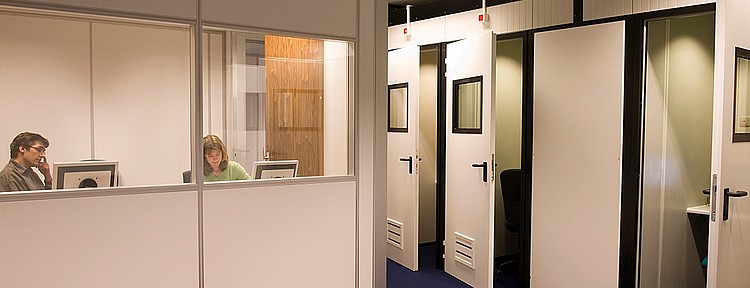Cubicles

Experiments in psychology and marketing often need to rely on large numbers of participants (e.g., some studies require up to 200 participants), who need to be isolated. The EBL has 28 cubicles to facilitate these kinds of experiments.
Three kinds of experiments use the cubicles:
Think-aloud
First, in numerous experiments, participants have to talk while performing the experiment. For example, studies on language and reading often require participants to read aloud words or text presented on the computer screen. Reaction times are measured and speech errors are scored and used to draw conclusions about the processes underlying language comprehension. Participants also talk aloud in studies on problem solving and memory. These experiments use ‘think-aloud’ procedures in which participants report the contents of their thoughts. Think-aloud protocols are used to track (problem solving) strategies. In these kinds of studies, participants obviously cannot be tested simultaneously in the same room, because hearing the other participants talk interferes with normal performance and changes behaviour. Cubicles are ideal for these kinds of experiments, because they allow for the testing of multiple participants in a time and space efficient manner.
Collaborative behaviour
Second, studies on collaborative behaviour often also require the use of cubicles. These studies in the fields of management and social and organizational psychology often depend on the illusion that the participants play against or with each other in an economic game. In these experiments participants may sometimes really interact with each other, but in other experiments the input that participants receive needs to be under complete control of the researcher. In the latter case though it is still important, however, that participants think that they are playing against each other. This can only be accomplished if participants see that other participants are being tested at the same time (i.e., see other participants entering other cubicles). On the other hand, participants may not directly communicate with each other to prevent contamination of the experimental manipulations (which can only be done of they are seated in different enclosed locations).
Multiple verbal instructions
Finally, cubicles allow for a very efficient testing of participants in experiments that require multiple verbal instructions be given to each participant individually at different stages of the experiment. This can only be done if the different participants do not hear the instructions given to other participants, which is possible only if they are seated in different cubicles.
The EBL has two 8-cublicle sections and one 12-cubicle section.
View more photos.


